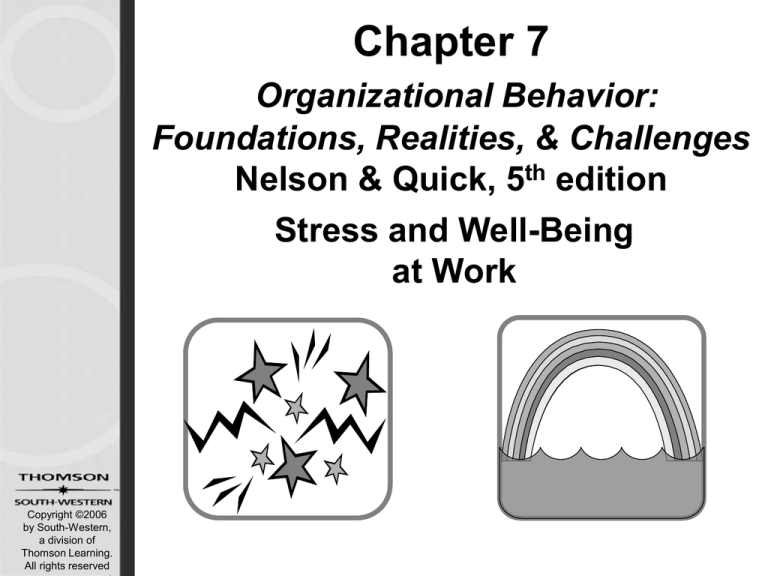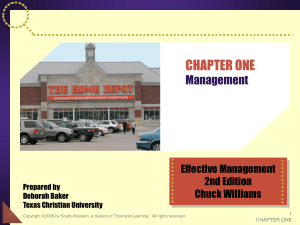
Chapter 7
Organizational Behavior:
Foundations, Realities, & Challenges
Nelson & Quick, 5th edition
Stress and Well-Being
at Work
Copyright ©2006
by South-Western,
a division of
Thomson Learning.
All rights reserved
What is Stress?
Stress –
Stressor –
Distress –
Strain –
Copyright ©2006
by South-Western,
a division of
Thomson Learning.
All rights reserved
What is Homeostasis?
Homeostasis –
Copyright ©2006
by South-Western,
a division of
Thomson Learning.
All rights reserved
4 Stress Approaches:
Homeostatic/Medical Approach
_________________
+
_____________________
____________
=
Copyright ©2006
by South-Western,
a division of
Thomson Learning.
All rights reserved
4 Stress Approaches:
Cognitive Appraisal Approach
•
•
Copyright ©2006
by South-Western,
a division of
Thomson Learning.
All rights reserved
•
4 Stress Approaches:
Cognitive Appraisal Approach
Copyright ©2006
by South-Western,
a division of
Thomson Learning.
All rights reserved
4 Stress Approaches:
Person–Environment Fit Approach
•
•
Copyright ©2006
by South-Western,
a division of
Thomson Learning.
All rights reserved
Copyright ©2006
by South-Western,
a division of
Thomson Learning.
All rights reserved
4 Stress Approaches:
Psychoanalytic Approach
Ego Ideal –
Self-Image –
=
The Stress Response
Copyright ©2006
by South-Western,
a division of
Thomson Learning.
All rights reserved
• Blood redirected from the
skin and internal organs
to brain and large
muscles
• Increased alertness:
improved vision, hearing,
and other sensory
responses
• Release of glucose and
fatty acids for sustenance
• Depression of immune
system, digestion, and
similar restorative
processes
Copyright ©2006
by South-Western,
a division of
Thomson Learning.
All rights reserved
Sources of Stress at Work
Work Demands
Task Demands
Role Demands
Interpersonal Demands
Physical Demands
Copyright ©2006
by South-Western,
a division of
Thomson Learning.
All rights reserved
Stress Sources at Work
Family Demands
Nonwork Demands
Personal Demands
Copyright ©2006
by South-Western,
a division of
Thomson
Learning. All rights
reserved
Stress Benefits and Costs
Benefits of Healthy, Normal Stress (Eustress)
Performance
Health
Costs of Distress
Individual
Organizational
Yerkes-Dodson Law
Performance arousal
Copyright ©2006
by South-Western,
a division of
Thomson Learning.
All rights reserved
High
Low
Low
(distress)
Optimum
(eustress)
High
(distress)
Stress level
Boredom from
understimulation
Optimum
stress load
Conditions
Distress from
perceived overstimulation
as stressful
Positive Stress
•
•
•
Copyright ©2006
by South-Western,
a division of
Thomson Learning.
All rights reserved
Negative Stress
Negative stress results from
–
–
–
Copyright ©2006
by South-Western,
a division of
Thomson Learning.
All rights reserved
Individual Distress
Copyright ©2006
by South-Western,
a division of
Thomson Learning.
All rights reserved
Organizational Distress
Participative Problems –
Performance Decrement –
Compensation Award –
Copyright ©2006
by South-Western,
a division of
Thomson Learning.
All rights reserved
Dealing with Stress
__________________
________________ –
a person breaks down
at his or her weakest
point
Copyright ©2006
by South-Western,
a division of
Thomson Learning.
All rights reserved
Are There
Gender-Related Stressors?
Sexual harassment
Early age fatal health problems
Long term disabling health problems
Violence
Copyright ©2006
by South-Western,
a division of
Thomson Learning.
All rights reserved
Type A Behavior Patterns
Type A Behavior Patterns –
–
–
–
–
Copyright ©2006
by South-Western,
a division of
Thomson Learning.
All rights reserved
Personality Hardiness
Copyright ©2006
by South-Western,
a division of
Thomson Learning.
All rights reserved
a personality
resistant to distress & characterized by
– challenge (versus threat)
– commitment (versus alienation)
– control (versus powerlessness)
a way of
managing stressful events by changing
them into subjectively less stressful
events (versus
passive avoidance of events by
decreasing interaction with the
environment)
Self-Reliance
Self-Reliance –
Counterdependence –
Overdependence –
Copyright ©2006
by South-Western,
a division of
Thomson Learning.
All rights reserved
Preventative Stress
Management
Preventative Stress Management –
Copyright ©2006
by South-Western,
a division of
Thomson Learning.
All rights reserved
Preventative Stress
Management
Primary Prevention –
Secondary Prevention –
Tertiary Prevention –
Copyright ©2006
by South-Western,
a division of
Thomson Learning.
All rights reserved
Preventative Stress Maintenance
Organizational Context
Organizational stressors
• Task demands
• Role demands
• Physical demands
• Interpersonal demands
Stress responses
• Individual
• Organizational
Distress
Individual problems
• Behavioral
•Medical
• Psychological
Organizational costs
• Direct
• Indirect
Preventive Medicine Context
Health risk factors
Asymptomatic
disease
Symptomatic
disease
SOURCE: Based on J. D. Quick, J. C. Quick, and D.L. Nelson. “The Theory of Preventive Stress Management in Organizations,” in C. L. Cooper, ed. Theories of Organizational Stress (Oxford, England: Oxford
University Press. 1998), 246-268.
Organizational Stress
Prevention
•
•
•
– job redesign
– goal setting
– role negotiation
– social support systems
Copyright ©2006
by South-Western,
a division of
Thomson Learning.
All rights reserved
Copyright ©2006
by South-Western,
a division of
Thomson Learning.
All rights reserved
Job Strain Model
Workload
Low
Low
Selfdetermination
High
Unresolved
strain
(ill health)
________
___
________
___
SOURCE: B. Gardell, “Efficiency and Health Hazards in Mechanized Work,” in J. C. Quick, R.S. Bhagat, J. E. Dalton, and J. D. Quick, eds., Work Stress: Health Care
Systems in the Workplace. Copyright © 1987. Reproduced with permission of Greenwood Publishing Group, Inc., Westport, CT.
Social Support at Work and Home
______________
Supervisor
Colleagues
Subordinates
Clients
_______________
Spouse Children
Parents In-laws
_______________
Minister/Rabbi
Friends
Support groups
________________
Individual
Physicians
Psychologists
___________________
Counselors
Business associations
Lawyers
Social clubs
Athletic groups
Copyright ©2006
by South-Western,
a division of
Thomson Learning.
All rights reserved
SOURCE: From J. C. Quick J. D. Quick, D. L. Nelson and J. J. Hurrell, Jr., in Preventive Stress Management in Organizations, 1997, p. 198. Copyright© 1997 by The American
Psychological Association. Reprinted with permission.
Copyright ©2006
by South-Western,
a division of
Thomson Learning.
All rights reserved
Individual Preventive
Stress Management
Primary Prevention
Alters the person’s internal self-talk and
reduces depression
Time management:
Improves planning and prioritizes activities
Leisure time activities: Balance work and non-work activities
Learned optimism:
Secondary Prevention
Physical exercise:
Relaxation training:
Diet:
Improves cardiovascular function and muscular
flexibility
Lowers all indicators of the stress response
Lowers the risk of cardiovascular disease and
improves overall physical health
Tertiary Prevention
Opening up:
Professional help:
Releases internalized traumas & emotional
tensions
Provides information, emotional support, and
therapeutic guidance
What Can Managers Do?
•
•
•
•
•
Copyright ©2006
by South-Western,
a division of
Thomson Learning.
All rights reserved







